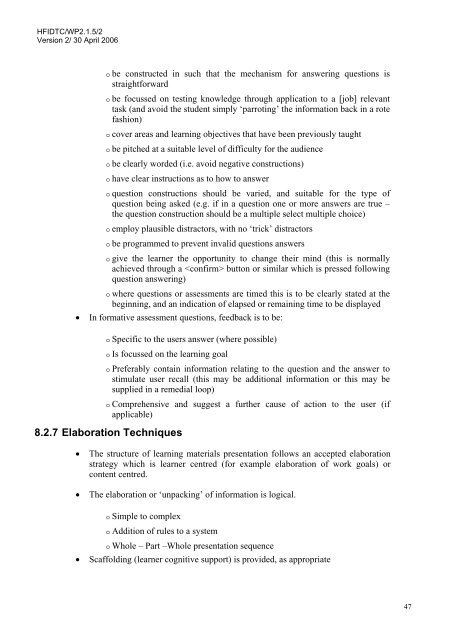E-learning Instructional Design Guidelines - Human Factors ...
E-learning Instructional Design Guidelines - Human Factors ...
E-learning Instructional Design Guidelines - Human Factors ...
You also want an ePaper? Increase the reach of your titles
YUMPU automatically turns print PDFs into web optimized ePapers that Google loves.
HFIDTC/WP2.1.5/2<br />
Version 2/ 30 April 2006<br />
o be constructed in such that the mechanism for answering questions is<br />
straightforward<br />
o be focussed on testing knowledge through application to a [job] relevant<br />
task (and avoid the student simply ‘parroting’ the information back in a rote<br />
fashion)<br />
o cover areas and <strong>learning</strong> objectives that have been previously taught<br />
o be pitched at a suitable level of difficulty for the audience<br />
o be clearly worded (i.e. avoid negative constructions)<br />
o have clear instructions as to how to answer<br />
o question constructions should be varied, and suitable for the type of<br />
question being asked (e.g. if in a question one or more answers are true –<br />
the question construction should be a multiple select multiple choice)<br />
o employ plausible distractors, with no ‘trick’ distractors<br />
o be programmed to prevent invalid questions answers<br />
o give the learner the opportunity to change their mind (this is normally<br />
achieved through a button or similar which is pressed following<br />
question answering)<br />
o where questions or assessments are timed this is to be clearly stated at the<br />
beginning, and an indication of elapsed or remaining time to be displayed<br />
• In formative assessment questions, feedback is to be:<br />
o Specific to the users answer (where possible)<br />
o Is focussed on the <strong>learning</strong> goal<br />
o Preferably contain information relating to the question and the answer to<br />
stimulate user recall (this may be additional information or this may be<br />
supplied in a remedial loop)<br />
o Comprehensive and suggest a further cause of action to the user (if<br />
applicable)<br />
8.2.7 Elaboration Techniques<br />
• The structure of <strong>learning</strong> materials presentation follows an accepted elaboration<br />
strategy which is learner centred (for example elaboration of work goals) or<br />
content centred.<br />
• The elaboration or ‘unpacking’ of information is logical.<br />
o Simple to complex<br />
o Addition of rules to a system<br />
o Whole – Part –Whole presentation sequence<br />
• Scaffolding (learner cognitive support) is provided, as appropriate<br />
47
















